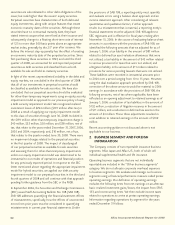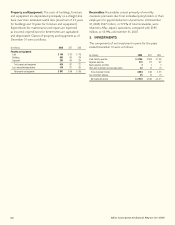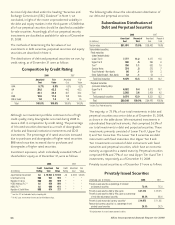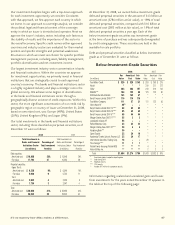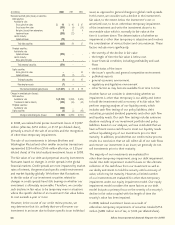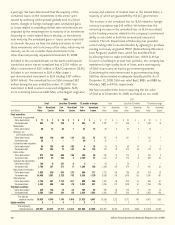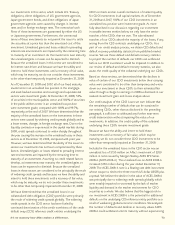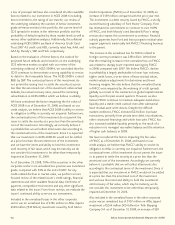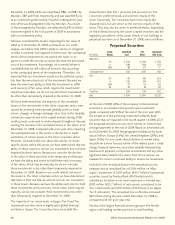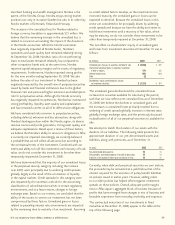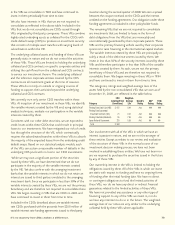Aflac 2008 Annual Report Download - page 75
Download and view the complete annual report
Please find page 75 of the 2008 Aflac annual report below. You can navigate through the pages in the report by either clicking on the pages listed below, or by using the keyword search tool below to find specific information within the annual report.
71
It’s no mystery how Aflac makes a difference.
analysis, we believe that SLM’s ability to service its obligation
to Aflac is currently not impaired. Furthermore, the contractual
terms of this investment do not permit the issuer to settle
the security at a price less than the amortized cost of the
investment. Accordingly, we currently believe it is probable that
we will collect all amounts due according to the contractual
terms of the investment. Since it is expected that our
investment in SLM would not be settled at a price less than
the amortized cost of the investment and we have the intent
and ability to hold this investment until recovery of fair value,
which may be maturity, we do not consider this investment to
be other-than-temporarily impaired at December 31, 2008.
Also included in the unrealized losses on the banks and
financial institutions sector was an unrealized loss of $173
million on Aflac Japan’s investments of $617 million (¥50.0
billion) in Takefuji Corporation (Takefuji). The unrealized loss
on Takefuji increased $186 million during the year ended
December 31, 2008. Takefuji is one of four major consumer
finance companies operating in Japan. In contrast to its peers,
which have moved into other lending sectors including real
estate. Takefuji has focused on small unsecured consumer
loans contributing to Takefuji’s stable operating assets. Takefuji
has a broad business network, including distribution alliances
with regional banks throughout Japan. Despite fourth quarter
2008 charges, Takefuji has maintained an adequate capital
position throughout 2008.
The increase in the unrealized loss for Takefuji related to
foreign currency translation was $34 million. We believe that
the remaining increase in the unrealized loss on Takefuji was
related to widening credit spreads on Takefuji as a result of the
deteriorating economic environment in Japan, especially in the
consumer lending markets. Takefuji, along with other Japanese
consumer finance companies, has experienced decreased loan
volume and profit reductions resulting from new legislation
in Japan that virtually eliminates consumer loan activity with
interest rates above 20% and lending greater than one third of
a customer’s annual income. Takefuji has also taken measures
strengthen its lending standards. Partly as a result of its efforts,
Takefuji’s loan charge-off rates saw a decline through the first
half of 2008. Our reviews of Takefuji reflect adequate near-
term liquidity and cash resources to meet its principal and
interest obligations for the next 24 months. During the fourth
quarter of 2008, Takefuji redeemed one of its debt issuances
to Aflac totaling ¥20 billion at 100% of its original par value.
We have considered the factors impacting the fair value of
Takefuji as of December 31, 2008, and based on our credit
analysis, we believe that Takefuji’s ability to service its obligation
to Aflac is currently not impaired. Furthermore, the contractual
terms of this investment do not permit the issuer to settle
the security at a price less than the amortized cost of the
investment. Accordingly, we currently believe it is probable that
we will collect all amounts due according to the contractual
terms of the investment. Since it is expected that our
investment in Takefuji would not be settled at a price less than
the amortized cost of the investment and we have the intent
and ability to hold this investment until recovery of fair value,
which may be maturity, we do not consider this investment to
be other-than-temporarily impaired at December 31, 2008.
An additional amount included in the unrealized losses in the
banks and financial institutions sector was an unrealized loss
of $110 million on Aflac Japan’s investment of $330 million
(¥30.0 billion) in bonds issued by Banco Espirito Santo, S.A.
(BES). The unrealized loss on BES increased $94 million during
the year ended December 31, 2008 as compared with the
prior year end. BES is a leading commercial bank in Portugal.
BES provides commercial and investment banking services,
and has leading market positions in Portugal in trade finance
and pension plan asset management and has expanded its
operations abroad to Brazil, Angola and Spain.
The increase in the unrealized loss for BES related to foreign
currency translation was $22 million. We believe that the
remaining increase in the unrealized loss on BES was related
to the current economic pressures on Portuguese banks’
profitability, liquidity and capital amid the weakened credit
environment and within the context of the global economic
downturn. Although BES maintains adequate regulatory
capital levels, its capital margins are relatively tight in light of
its business profile, the declining operating environment for
BES and new guidance from the Bank of Portugal regarding
the need for higher capitalization. To maintain stability and
regular funding in the Portuguese financial system, Portugal
created a State Guarantee regime, under which BES announced
its intention to issue additional in debt benefiting from this
guarantee. This new guaranteed debt will likely ease the
refinancing requirements at BES through the next three years
and substantially improve its liquidity. On November 21, 2008
Fitch affirmed BES’ subordinated debt rating at A, citing the
strength of BES’ banking operations in a difficult economy while
also noting the low deposit ratio to total loans and relatively
low capital levels. BES subordinated debt also carries ratings of
A1 and A- by Moody’s and Standard & Poor’s, respectively.
We have considered the factors impacting the fair value
of BES as of December 31, 2008, and based on our credit
analysis, we believe that BES’ ability to service its obligation to
Aflac is currently not impaired. Furthermore, the contractual
terms of this investment do not permit the issuer or its parent
to settle the security at a price less than the amortized cost
of the investment. Accordingly, we currently believe it is
probable that we will collect all amounts due according to the
contractual terms of the investment. Since it is expected that



